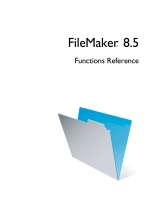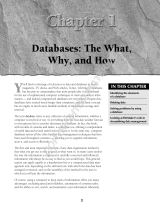
Chapter 2 | Creating database solutions 10
Runtime applications do not have all the functionality and features of FileMaker Pro. For a
complete list of the differences between the runtime application and FileMaker
Pro, see
Appendix A, “Feature comparison of the runtime application with FileMaker Pro.”
You may need to bind your database files several times before you prepare them for delivery to
your users. When you have completed development and the final version is bound and ready to
distribute, you should thoroughly test your runtime solution to ensure that it behaves as expected.
Note FileMaker Pro and FileMaker Pro Advanced allow you to include as many database tables
as you need in a database file. This capability eliminates one of the main reasons for using
multiple files. However, other elements, like scripts and access privileges, are stored at the file
level and so some complex solutions will still benefit from using multiple files.
Before you begin to build your database solution, you need to decide how users will interact with
it. Your database solution might have any of the following components:
1 a primary database file that connects all of the auxiliary files
1 scripts and buttons to open auxiliary files, return to the primary file, display a splash screen
layout at startup, or quit a runtime application
1 common elements and a consistent appearance for cross-platform solutions
1 tooltips and custom menus
1 an About layout to introduce your solution (required)
1 a custom Help system that provides usage tips for your solution
1 multiple privilege sets that can specify levels of access to layouts, menus, specific tables,
record, fields, and so on
1 password-protected accounts assigned to privilege sets that determine the level of access of
account users
For information about what users need in order to use your runtime database solution, see
“Distributing runtime solutions” on page 12.
Converting and upgrading previous solutions
If you have developed a FileMaker Pro runtime database solution using the Solutions
Development Kit (SDK) for FileMaker
Pro 3.0 or earlier, the Binder utility in the FileMaker Pro 4.0
Developer Edition, or the Developer Tool in FileMaker Developer 5.x and 6.0, you can upgrade
your solution and provide your users with the converted files. Files bound to a runtime application
using the earlier tools must be rebound using the Developer Utilities.
You must convert FileMaker Pro files created in earlier versions to FileMaker Pro 12 format. Files
created using versions prior to FileMaker
Pro 7 must be converted to version 7, 8, 9, 10, or 11,
then converted to version 12. You can convert a single file or convert multiple files at once. For
more information about converting files, see Help.
After you have converted the files, you can upgrade them to take advantage of newer
FileMaker
Pro and FileMaker Pro Advanced features. If necessary, create scripts to import users’
existing data from the old runtime database solution into the new, upgraded solution. See Help for
more information on importing data into upgraded runtime solutions. Use the Developer Utilities
to bind the solution files into a new, upgraded runtime database solution.
Distribute the new upgraded runtime database solution and provide instructions for how users can
upgrade their files by converting the old files in the new runtime application and importing their data.























